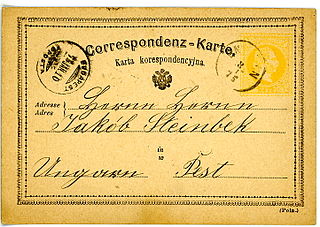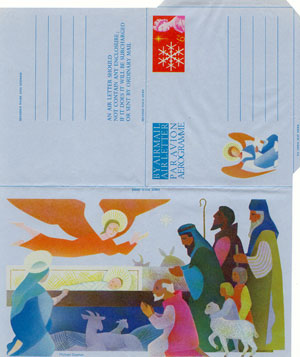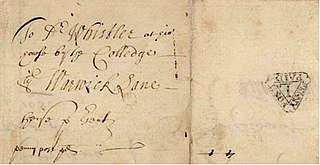
A stamped envelope or postal stationery envelope (PSE) is an envelope with a printed or embossed indicium indicating the prepayment of postage. It is a form of postal stationery.

A stamped envelope or postal stationery envelope (PSE) is an envelope with a printed or embossed indicium indicating the prepayment of postage. It is a form of postal stationery.
The Sherborn Collection in the British Library Philatelic Collections is an important collection of 1841-85 Queen Victoria embossed 1d pink stamped envelopes. The collection was formed by C. Davis Sherborn and donated to the British Museum in 1913. [1]

In August 1852, an Act of the US Congress authorized the Postmaster General to provide "suitable letter envelopes with such watermarks or other guards against counterfeits... with the addition of the value or denomination of the postage stamps so printed or impressed thereon...." The first result was the 1853 Nesbitt issues of stamped envelopes, which was named after the private contractor who produced them for the government. [2] When the different envelope sizes, knives, colors, dies to print the indicia, and denominations are combined, there are literally thousands of different stamped envelopes produced for the US. [3]
Collectors of stamped envelopes use a catalog to know what has been issued.
Siegfried Ascher was the first to try to comprehensively document all countries' postal stationery including stamped envelopes. [4] This was followed some 40 years later by the Higgins & Gage World Postal Stationery Catalog. Though now out of date, it is still frequently cited since it covers all countries and no other comprehensive catalog has been attempted since. The H&G catalog, as it is known, describes stamped envelopes by the envelope size, the depicted indicia and its valuations, some corner cards, while sometimes disregarding envelope color.
The Scott catalogue is the United States envelope color and value of the indicia which is perfect for dealing with cut squares, but falls short of information needed to collect entires, i.e. the whole envelope. The United Postal Stationery Society has two published books cataloging U.S. stamped envelopes. [2] [3] These books describe all of the other stated criteria plus the envelope knife making them the most complete U.S. stamped envelope catalogs.
British postal stationery to 1970 has been comprehensively documented [5] and Edifil is a Spanish company that has comprehensive listings for stamped envelopes of Spain, Cuba, Philippines and Puerto Rico.
Australian Postal Stationery is covered by a catalogue from Brusden White. The 'Australian Commonwealth Specialists' Catalogue: Postal Stationery including Australian Territories' was first issued in 2013. In 2018 a fully revised 2nd edition was released. Fully illustrated, it is the most comprehensive reference work for these Australian issues. [6]
Most stamped envelopes are collected as entires. In the 19th century the practice was to collect cut squares (or cut-outs in the U.K.) [7] which involved cutting the embossed indicia from a postal envelope. This destroyed the envelope. As a result, one cannot tell from a cut square what specific envelope it came from and, many times, the cancellation information. The manner in which the stamped envelope is cut before folding (that is, its knife) vanishes on a cut square. The envelope size disappears, too, with a cut square.
In collecting entires, a single indicium may appear on many different sizes of envelopes. Some countries have issued the same indicium on different paper types: laid and wove. Likewise it is common for the same indicium to be embossed onto paper of several different colors. Finally, two envelopes of the same size can have a different flap size indicating that they were cut from a different knife. Rarely, an uncatalogued color, or displaced surcharge, or albino indicium, or inside-out folding of the envelope may appear, in which case you have found something of value. All of these attributes relate to mint or unused envelopes. When you add a postmark from a used envelope to the mix, the collecting possibilities explode. What was formerly in fashion, collecting only mint examples, has changed because many collectors seem to find used PSE collections more interesting. [7]

Some postal stationery envelopes contain a corner card, a printed return address on the envelope, usually in the upper left hand corner. This can range from a simple town and country notation to an elaborate illustrated advertisement for a business. Corner cards are either applied by an after-market print shop or by dealing with the government related entity that produces the stamped envelopes.

Philately is the study of postage stamps and postal history. It also refers to the collection and appreciation of stamps and other philatelic products. While closely associated with stamp collecting and the study of postage, it is possible to be a philatelist without owning any stamps. For instance, the stamps being studied may be very rare or reside only in museums.

Stamp collecting is the collecting of postage stamps and related objects. It is an area of philately, which is the study of stamps. It has been one of the world's most popular hobbies since the late nineteenth century with the rapid growth of the postal service, as a stream of new stamps was produced by countries that sought to advertise their distinctiveness through their stamps.

A cancellation is a postal marking applied on a postage stamp or postal stationery to deface the stamp and to prevent its reuse. Cancellations come in a huge variety of designs, shapes, sizes, and colors. Modern cancellations commonly include the date and post office location where the stamps were mailed, in addition to lines or bars designed to cover the stamp itself. The term "postmark" refers specifically to the part that contains the date and posting location, but the term is often used interchangeably with "cancellation" as it may serve that purpose. The portion of a cancellation that is designed to deface the stamp and does not contain writing is also called the "obliteration" or killer. Some stamps are issued pre-cancelled with a printed or stamped cancellation and do not need to have a cancellation added. Cancellations can affect the value of stamps to collectors, positively or negatively. Cancellations of some countries have been extensively studied by philatelists, and many stamp collectors and postal history collectors collect cancellations in addition to the stamps themselves.

Postal cards are postal stationery with an imprinted stamp or indicium signifying the prepayment of postage. They are sold by postal authorities. On January 26, 1869, Dr. Emanuel Herrmann of Austria described the advantages of a Correspondenz Karte. By October 1, 1869 the world's first postal card was produced by Austria-Hungary. They caught on quickly. By the end of 1870, Great Britain, Finland, Switzerland and Württemberg joined the countries issuing postal cards. In the United States, they were first produced in 1873. Some of the forms taken by postal cards include the regular single card which may be commemorative or definitive, attached message-reply cards, airmail postal cards, and official postal cards used for official government business with a "penalty for private use".

A piece of postal stationery is a stationery item, such as a stamped envelope, letter sheet, postal card, lettercard, aerogram or wrapper, with an imprinted stamp or inscription indicating that a specific rate of postage or related service has been prepaid. It does not, however, include any postcard without a pre-printed stamp, and it is different from freepost for preprinted cards issued by businesses. In general, postal stationery is handled similarly to postage stamps; sold from post offices either at the face value of the printed postage or, more likely, with a surcharge to cover the additional cost of the stationery. It can take the form of an official mail issue produced only for the use of government departments.

An aerogram, aerogramme, aérogramme, air letter or airletter is a thin lightweight piece of foldable and gummed paper for writing a letter for transit via airmail, in which the letter and envelope are one and the same. Most postal administrations forbid enclosures in these light letters, which are usually sent abroad at a preferential rate. Printed warnings existed to say that an enclosure would cause the mail to go at the higher letter rate.

The British Central Africa Protectorate existed in the area of present-day Malawi between 1891 and 1907.

In philately, indicia are markings on a mail piece showing that postage has been prepaid by the sender. Indicia is the plural of the Latin word indicium, meaning distinguishing marks, signs or identifying marks. The term imprinted stamp is used more or less interchangeably, but some indicia are not imprinted stamps. One example is the handstamp, which can be seen in a photo on this page.

In philatelic terminology a letter sheet, often written lettersheet, is a sheet of paper that can be folded, usually sealed, and mailed without the use of an envelope, or it can also be a similar item of postal stationery issued by a postal authority. Letter sheets derive from the form in which written correspondence was made up before the mid-19th century—letters were written on one or more sheets of paper that were folded and sealed in such a way that the address could be written on the outside.

A specimen stamp is a postage stamp or postal stationery indicium sent to postmasters and postal administrations so that they are able to identify valid stamps and to avoid forgeries. The usual method of invalidating the stamps is either overprinting in ink or perforating the word Specimen across the stamp and where English is not the common language, the words Muestra (Spanish), Monster (Dutch), Muster (German) or Образец have been used instead.
Louis Henry Barkhausen (1877–1962), of Chicago, Illinois, was a stamp collector who specialized in the collection and study of American postal stationery.

In philately, an imprinted stamp is a stamp printed onto a piece of postal stationery such as a stamped envelope, postal card, letter sheet, letter card, aerogram or wrapper. The printing may be flat upon the surface of the paper, or embossed with a raised relief. An imprinted stamp is also known as unadhesive stamp or indicium.

In philately a cut-out is an imprinted stamp cut from an item of postal stationery such as a postal card, letter sheet, aerogramme or wrapper that may have been used as a normal stamp.
Knife is the cutting die for envelope or wrapper blanks. It is called a knife rather than a die because the latter is an object that makes an embossed printed impression of the stamp or indicium on the envelope. Traditionally, a knife would normally be made of forged steel. It was placed on a stack of paper with the sharp edge against the paper. The press head forced the cutting edge all the way through the stack of paper. The cut blanks were removed from the knife and the process repeated. Not only could it cut out the odd shape of an envelope, but a knife could be used to cut out shapes of airmail stickers or gummed labels in the shape of stars or circles. The variety of shapes a knife could cut would be infinite.

In philately a wrapper is a form of postal stationery which pays the cost of the delivery of a newspaper or a periodical. The wrapper is a sheet of paper, large enough to wrap around a folded or rolled newspaper and with an imprinted stamp to pay the cost of postage. Some catalogs and reference books refer to a wrapper as postal bands which comes from the French term bandes postale. Still others refer to it as a newspaper wrapper or periodical wrapper.

The Fletcher Collection is Hugh Greenwell Fletcher's lifetime philatelic collection of British postage stamps and British stamps used abroad including overprints and non-stamp items such as postal stationery. On his death in 1968, the collection was bequeathed to the Bruce Castle Museum in Tottenham, once the home of Sir Rowland Hill. The collection was donated to the British Library in 1989.

The term earliest reported postmark or ERP is a term used by the United Postal Stationery Society (UPSS) for the past four or more decades. They have established a database in which the earliest postmarks on stamped envelopes or postal card or letter sheets is kept. Postmarks are typically dated from days to many months after the date of issuance. An envelope can come out in varying sizes, colors, or shapes without notification to the public. Collecting the earliest reported postmark for a particular variety is an ongoing effort.

The Sherborn Collection is a collection of 1841-85 Queen Victoria embossed 1d pink postal stationery stamped envelopes that forms part of the British Library Philatelic Collections. The collection was formed by C. Davis Sherborn and donated to the British Museum in 1913.
The Postal Stationery Society of Great Britain was formed in April 1941, with the aim of encouraging philatelists to collect and study postal stationery, in addition to the accepted hobby of stamp collecting. The Society had about 20 members in the beginning, some of whom carried out detailed research on issues of postal stationery from many different postal administrations, while others sent in questions on material they had bought and would like to find out more. All this was reported in the Society's newsletters which were issued 2 or 3 times per annum in the early years, and more frequently later on. The newsletters were duplicated sheets of paper, initially one foolscap sheet for each issue, although this later became two sheets per issue. Copies of these newsletters are held in the libraries of the Postal Stationery Society and the Royal Philatelic Society London.